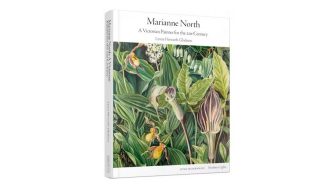Introducing Marianne North - A Victorian Painter for the 21st Century
Dr. Lynne Howarth-Gladston introduces us to this ground-breaking woman artist and identifier of new plant species.
Dr. Lynne Howarth-Gladston introduces us to this ground-breaking woman artist and identifier of new plant species.

In this blogpost Lynne Howarth-Gladston – author of the newly published book MARIANNE NORTH: A VICTORIAN PAINTER FOR THE 21ST CENTURY, co-published with Royal Botanic Gardens, Kew – introduces us to this ground-breaking woman artist and identifier of new plant species, and outlines how her new book takes important steps towards reclaiming Marianne North’s contribution to visual culture is a significant one that deserves to be revisited in the 21 century...
Marianne North, (1830-1890) was an amateur painter, whose family was a part of the British upper middle class. After being left a substantial inheritance by her father in 1871, North decided to try to paint the flora and fauna of the world. North wrote travel diaries that describe numerous intrepid overseas adventures, along with personal encounters with plants, peoples, and animals. North was also concerned with the prevailing environmental issues of the day that often involved industrial damage of the natural world – including the destruction of trees, which North found particularly upsetting. North’s death in 1890, meant that the first two volumes of the diaries were published posthumously in 1892, by Macmillan and Son, with a further volume being published in 1893. Edited by her sister Catherine Addington Symonds, the diaries are also a record of the prevailing colonialism present throughout North’s lifetime.
Marianne North, Painting 367, A Giant Kniphofia near Grahamstown, oil on board, 50.5 x 35.2 cm, Royal Botanic Gardens, Kew.
North’s paintings have continually challenged the conventions of botanical illustration and fine art, by combining visual conventions and methodologies found in both practices. North’s paintings often utilised compositional strategies and painterly outcomes not only in depictions of the natural environment but also regarding the production of still life paintings.
Marianne North, Painting 047, Flowers of Datura and Humming birds, Brazil, oil on board, 50.8x35.4 cm, Royal Botanic Gardens, Kew.
During her lifetime, North knew many of the greatest scientific minds of the day, including Charles Darwin, (1809-1882), the author of On The Origin of Species, and Louis Agassiz (1807-1873), the Swiss-American scientist and Glacier specialist; both of whose ideas informed North’s paintings scientific outlook. Not only are there incredible detailed depictions of flora and fauna in North’s pianting but also geological structures, and topographical details of landscapes. North also emulated the painting styles of many 19 -century fine art painters, including some of the compositional tropes of The Pre-Raphaelite Brotherhood, family friend, Edward Lear, (1812- 1888), and the American Landscape painter Frederick Edwin Church, (1826-1900), a founding member of the American painting group The Hudson River School.
Marianne North, Painting 201, View of Lake Donner, Sierra Nevada, oil on board, 35x44 cm, Royal Botanic Gardens, Kew.
North’s inheritance financed a self-designed gallery to house her paintings set within the grounds of the Royal Botanic Gardens, Kew, which opened to the public in 1882. An extension was added to the gallery between 1884-5, with the gallery re-opening to the public again in 1886. The gallery, which still stands, houses over 800 of North’s paintings and 16 large decorative panels. The paintings are arranged according to geographical countries and regions in a manner similar to a giant cabinet of curiosities. The amateur architect James Fergusson (1808-1886) assisted with the design and building of the North gallery. Both North and Fergusson took into consideration Kew’s many garden follies as part of the gallery’s design. Fergusson’s contribution to the design of the gallery’s exterior incorporates Italianate stylizations. The affixed pre-fabricated iron column and railing veranda was a fashionable addition to many buildings at the time, and was part of British colonial architecture.
Exterior of the Marianne North Gallery, c.2007, photograph, Royal Botanic Gardens, Kew.
North had complete control over the presentation of her paintings inside the gallery. She chose simple Japanned frames which were then fixed into an interlocking system that gives viewers an overwhelmingly sublime experience. The presentation of paintings in the North gallery signifies North’s thoughts and feelings on early environmentalism as well as modern 19 -century scientific and artistic concepts. The gallery was also visited by fashionable Victorian society who encountered extraordinary depictions of places they would never visit.
Restored Interior of the Marianne North Gallery, photograph, Royal Botanic Gardens, Kew.
The North gallery’s interior resonates with 19 -century conceptions of the gesamtkunstwerk, or complete artwork, and a then prevailing pre cinematic panoramic visual representation. North’s paintings do not conform exactly to the accepted conventions of scientific botanical illustration. They and the North Gallery at Kew remain important, however, as a combination of scientific and artistic outlooks and methods resonant with contemporary cultural concerns, including those related to climate change. North’s contribution to visual culture is a significant one that deserves to be revisited in the 21 century.
Dr. Lynne Howarth-Gladston is a research affiliate of the UNSW Judith Neilson Chair of Contemporary Art and has worked together with the Chair on several exhibitions and publications, including the exhibition 'Rain on the Platform - Tan Lijie, Selected Works' and the book 'Rethinking Displays of Chinese Contemporary Art'.
This blogpost is republished from Lund Humphries. Read the original article.
All images © The Trustees of the Royal Botanic Gardens, Kew. With the kind permissions of the Trustees of the Royal Botanic Gardens, Kew, Surrey, UK.